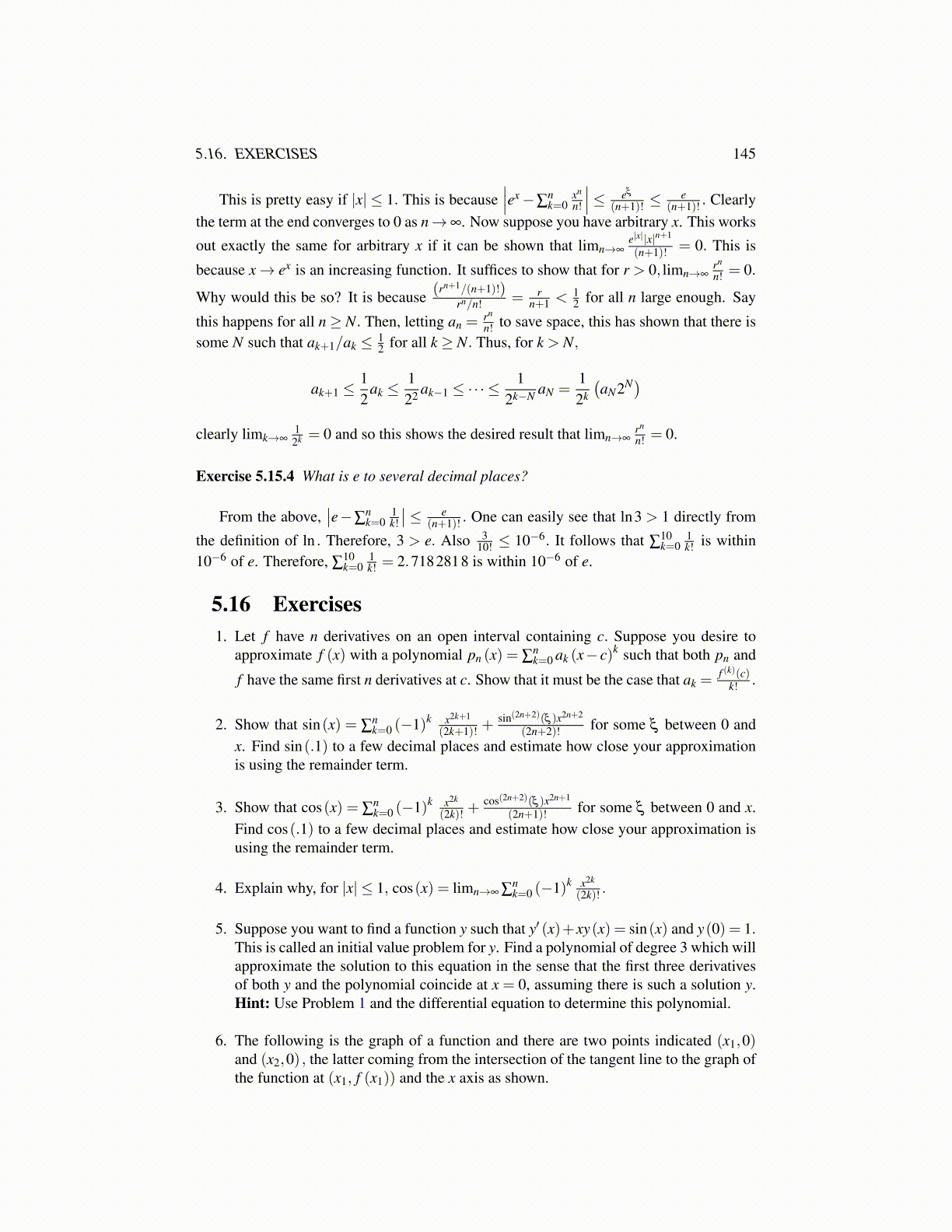
5.16. EXERCISES 145
This is pretty easy if |x| ≤ 1. This is because∣∣∣ex −∑
nk=0
xn
n!
∣∣∣ ≤ eξ
(n+1)! ≤e
(n+1)! . Clearlythe term at the end converges to 0 as n → ∞. Now suppose you have arbitrary x. This works
out exactly the same for arbitrary x if it can be shown that limn→∞e|x||x|n+1
(n+1)! = 0. This is
because x → ex is an increasing function. It suffices to show that for r > 0, limn→∞rn
n! = 0.
Why would this be so? It is because (rn+1/(n+1)!)rn/n! = r
n+1 < 12 for all n large enough. Say
this happens for all n ≥ N. Then, letting an =rn
n! to save space, this has shown that there issome N such that ak+1/ak ≤ 1
2 for all k ≥ N. Thus, for k > N,
ak+1 ≤12
ak ≤122 ak−1 ≤ ·· · ≤ 1
2k−N aN =12k
(aN2N)
clearly limk→∞12k = 0 and so this shows the desired result that limn→∞
rn
n! = 0.
Exercise 5.15.4 What is e to several decimal places?
From the above,∣∣e−∑
nk=0
1k!
∣∣ ≤ e(n+1)! . One can easily see that ln3 > 1 directly from
the definition of ln . Therefore, 3 > e. Also 310! ≤ 10−6. It follows that ∑
10k=0
1k! is within
10−6 of e. Therefore, ∑10k=0
1k! = 2.7182818 is within 10−6 of e.
5.16 Exercises1. Let f have n derivatives on an open interval containing c. Suppose you desire to
approximate f (x) with a polynomial pn (x) = ∑nk=0 ak (x− c)k such that both pn and
f have the same first n derivatives at c. Show that it must be the case that ak =f (k)(c)
k! .
2. Show that sin(x) = ∑nk=0 (−1)k x2k+1
(2k+1)! +sin(2n+2)(ξ )x2n+2
(2n+2)! for some ξ between 0 andx. Find sin(.1) to a few decimal places and estimate how close your approximationis using the remainder term.
3. Show that cos(x) = ∑nk=0 (−1)k x2k
(2k)! +cos(2n+2)(ξ )x2n+1
(2n+1)! for some ξ between 0 and x.Find cos(.1) to a few decimal places and estimate how close your approximation isusing the remainder term.
4. Explain why, for |x| ≤ 1, cos(x) = limn→∞ ∑nk=0 (−1)k x2k
(2k)! .
5. Suppose you want to find a function y such that y′ (x)+xy(x) = sin(x) and y(0) = 1.This is called an initial value problem for y. Find a polynomial of degree 3 which willapproximate the solution to this equation in the sense that the first three derivativesof both y and the polynomial coincide at x = 0, assuming there is such a solution y.Hint: Use Problem 1 and the differential equation to determine this polynomial.
6. The following is the graph of a function and there are two points indicated (x1,0)and (x2,0) , the latter coming from the intersection of the tangent line to the graph ofthe function at (x1, f (x1)) and the x axis as shown.